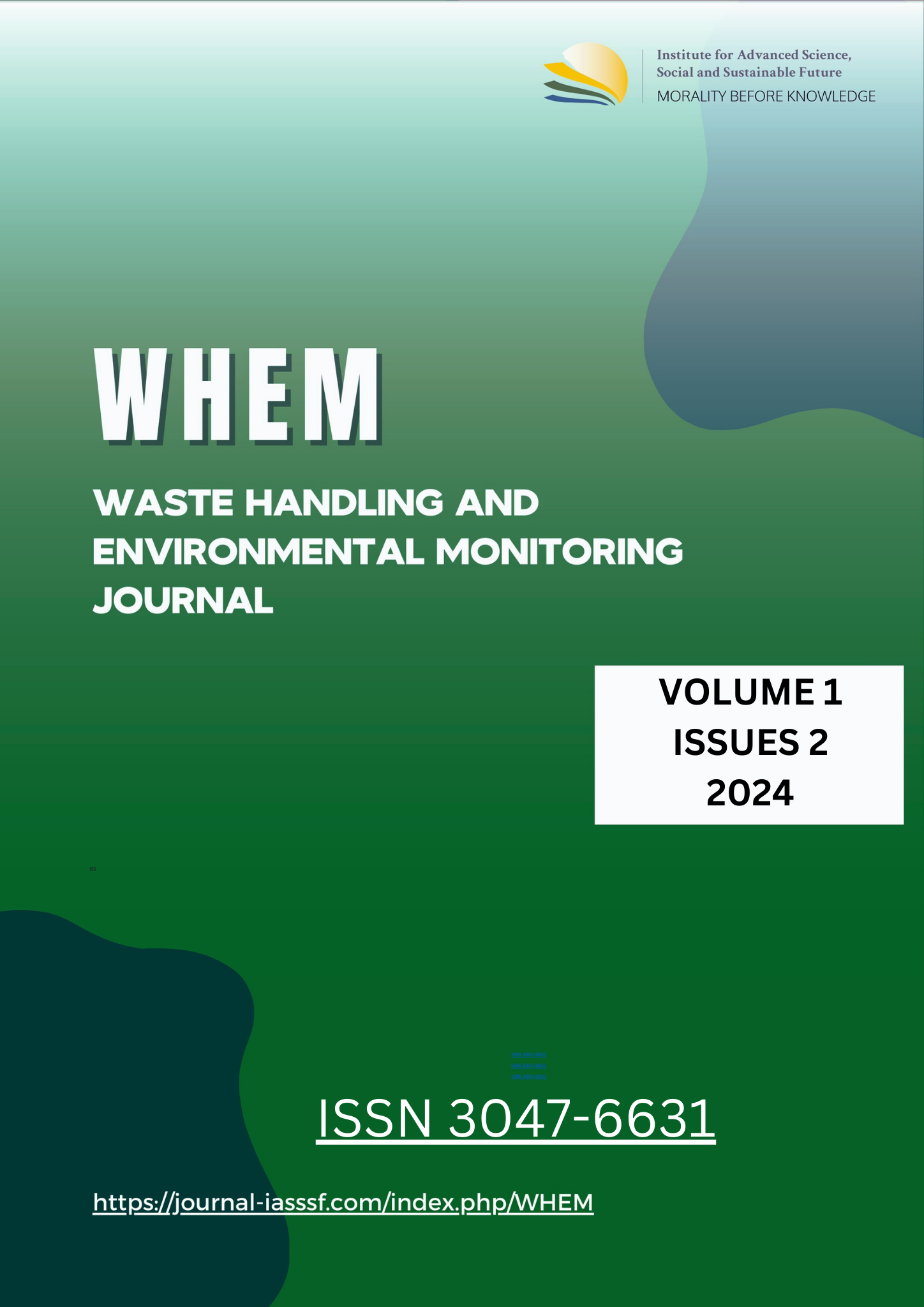Potensi precision farming dalam penerapan prinsip reduce untuk mengurangi limbah sumber daya pertanian
DOI:
https://doi.org/10.61511/whem.v1i2.2024.1239Keywords:
precision farming, reduce principle, sustainable agricultureAbstract
Background: The increase in agricultural production is often accompanied by excessive use of chemical inputs, contributing to environmental pollution. Precision farming is a modern approach that can address this challenge by optimizing input use through advanced technology. This paper explores the application of the reduce principle in precision farming to support efficient use of fertilizers and other resources. Method: The method used is a literature review of various published studies related to precision farming and agricultural land management. Findings: The application of the reduce principle in fertilization activities with precision farming can reduce fertilizer waste by up to 50%, increase land productivity by 10%, and minimize harmful environmental effects, such as groundwater pollution and greenhouse gas emissions. Precision farming also improves irrigation efficiency through precision irrigation technology. Conclusion: This study confirms that applying precision farming with a focus on the reduce principle not only supports sustainable agriculture but also provides economic benefits for farmers by reducing production costs. Innovations in precision farming technology, such as the integration of AI-based sensors and IoT, further enhance potential efficiencies in the future. Novelty/Originality of this article: Emphasizing the use of the reduce principle in precision farming as a primary strategy to achieve more efficient and environmentally friendly agriculture aligns with the goals outlined in the Sustainable Development Goals (SDGs) for responsible production.
References
Afzali, S., Mosharafian, S., van Iersel, M. W., & Mohammadpour Velni, J. (2021). Development and implementation of an IoT-enabled optimal and predictive lighting control strategy in greenhouses. Plants, 10(12), 2652. https://doi.org/10.3390/plants10122652
Anderson, H. B., Nilsen, L., Tømmervik, H., Karlsen, S. R., Nagai, S., & Cooper, E. J. (2016). Using ordinary digital cameras in place of near-infrared sensors to derive vegetation indices for phenology studies of High Arctic vegetation. Remote Sensing, 8(10), 847. https://doi.org/10.3390/rs8100847
Arifin, Z. (2002, July 9). Program Penyiapan Pupuk Nasional Tahun 2002 – 2007 untuk Ketahanan Pangan. Peningkatan Produktivitas melalui Penguasaan Teknologi Inovatif menuju Kemandirian Industri Pertanian. Prosiding Seminar Nasional, Jakarta, Persatuan Insinyur Indonesia, 31–36.
Arimbi, D. (2018). Optimalisasi Pengelolaan Sampah Berbasis 3R (Reduce, Reuse, Recycle) di Kelurahan Jambangan, Surabaya. Tesis. Institut Teknologi Surabaya. Surabaya.
Aune, J. B., Coulibaly, A., & Giller, K. E. (2017). Precision farming for increased land and labour productivity in semi-arid West Africa. A review. Agronomy for sustainable development, 37, 1-10. https://doi.org/10.1007/s13593-017-0424-z
Buja, I., Sabella, E., Monteduro, A. G., Chiriacò, M. S., De Bellis, L., Luvisi, A., & Maruccio, G. (2021). Advances in plant disease detection and monitoring: From traditional assays to in-field diagnostics. Sensors, 21(6), 2129. https://doi.org/10.3390/s21062129
Dhanaraju, M., Chenniappan, P., Ramalingam, K., Pazhanivelan, S., & Kaliaperumal, R. (2022). Smart farming: Internet of Things (IoT)-based sustainable agriculture. Agriculture, 12(10), 1745. https://doi.org/10.3390/agriculture12101745
Gebbers, R., & Adamchuk, V. I. (2010). Precision agriculture and food security. Science, 327(5967), 828-831. https://doi.org/10.1126/science.1183899
Ginting, E. N., & Wiratmoko, D. (2021). Potensi dan Tantangan Penerapan Precision Farming dalam Upaya Membangun Perkebunan Kelapa Sawit yang Berkelanjutan. War. PPKS, 26(2), 55-65. https://doi.org/10.22302/iopri.war.warta.v26i2.47
Godwin, R. J., Wood, G. A., Taylor, J. C., Knight, S. M., & Welsh, J. P. (2003). Precision farming of cereal crops: a review of a six year experiment to develop management guidelines. Biosystems Engineering, 84(4), 375-391. https://doi.org/10.1016/S1537-5110(03)00031-X
Kamienski, C., Soininen, J. P., Taumberger, M., Dantas, R., Toscano, A., Salmon Cinotti, T., ... & Torre Neto, A. (2019). Smart water management platform: IoT-based precision irrigation for agriculture. Sensors, 19(2), 276. https://doi.org/10.3390/s19020276
Ogunleye, G. O., Fashoto, S. G., Mashwama, P., Arekete, S. A., Olaniyan, O. M., & Omodunbi, B. A. (2018). Fuzzy logic tool to forecast soil fertility in Nigeria. The Scientific World Journal, 2018(1), 3170816. https://doi.org/10.1155/2018/3170816
Pitono, J. (2019). The Precision Farming on Pepper Cultivation. Perspektif, 18(2), 91- 103. http://dx.doi.org/10.21082/psp.v18n2.2019.91-103
Prabawa, S., Pramudya, B., Astika, I. W., Setiawan, R. P. A., & Rustiadi, E. (2008, November 18-19). Precision Farming Approach in N, P, and K Fertilization of Sugar Cane Cultivation: Case Study in PT Gula Putih Mataram. Prosiding Seminar Nasianal Teknik Pertanian 2008, Yogyakarta, 1–15.
Putra, B. T. W. (2020). Sosialisasi Precision Farming untuk Monitoring Tanaman Perkebunan dan Hortikultura Kabupaten Jember. Warta Pengabdian, 14(4), 231-239. https://doi.org/10.19184/wrtp.v14i4.16704
Putra, B. T. W., & Soni, P. (2017). Evaluating NIR-Red and NIR-Red edge external filters with digital cameras for assessing vegetation indices under different illumination. Infrared Physics & Technology, 81, 148-156. https://doi.org/10.1016/j.infrared.2017.01.007
Rahmadani, F. 2017. Analisis Efisiensi Penggunaan Pupuk pada Tanaman Kelapa Sawit Perkebunan Rakyat dengan Menggunakan Metode Data Envelopment Analysis. Skripsi. Universitas Sumatera Utara.
Rendana, M., Rahim, S. A., Idris, W. M. R., Lihan, T., & Rahman, Z. A. (2016). Mapping nutrient status in oil palm plantation using geographic information system. Asian Journal of Agricultural Research, 10(3), 144-153. http://dx.doi.org/10.3923/ajar.2016.144.153
Rusmin, D., Suryadi, R., Pitono, J., Melati, & Permadi, R. A. (2018). Optimasi Produksi Benih Lada Bermutu Melalui Fertigasi Statis dan Sistem Tanam Sisip dalam Baris. Balitro. Bogor. Science, 327(5967), 828–831.
Sitthaphanit, S., Limpinuntana, V., Toomsan, B., Panchaban, S., & Bell, R. W. (2009). Fertiliser strategies for improved nutrient use efficiency on sandy soils in high rainfall regimes. Nutrient cycling in agroecosystems, 85, 123-139. https://doi.org/10.1007/s10705-009-9253-z
Sureshkumar, P., Geetha, P., Kutty, M. N., Kutty, C. N., & Pradeepkumar, T. (2016). Fertigation-the key component of precision farming. Journal of Tropical Agriculture, 54(2), 103-103. https://jtropag.kau.in/index.php/ojs2/article/view/451
Takele, C., & Iticha, B. (2020). Use of infrared spectroscopy and geospatial techniques for measurement and spatial prediction of soil properties. Heliyon, 6(10). https://www.cell.com/heliyon/fulltext/S2405-8440(20)32112-5
Umeda, M., Iida, M., & Suguri, M. (1999). Research at Laboratory of Farm Machinery of Kyoto University. https://www.cabidigitallibrary.org/doi/full/10.5555/19992402478
Downloads
Published
How to Cite
Issue
Section
Citation Check
License
Copyright (c) 2024 Waste Handling and Environmental Monitoring

This work is licensed under a Creative Commons Attribution 4.0 International License.














